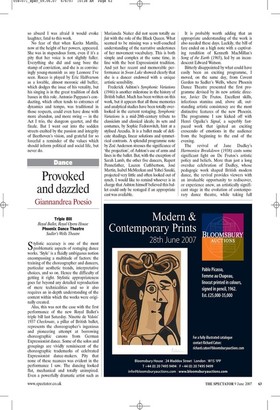Provoked and dazzled
Giannandrea Poesio Triple Bill Royal Ballet, Royal Opera House Phoenix Dance Theatre Sadler's Wells Theatre Stylistic accuracy is one of the most problematic aspects of restaging dance works. 'Style' is a fluidly ambiguous notion encompassing a multitude of factors: the training of the choreographer and dancers, particular aesthetic trends, interpretative choices, and so on. Hence the difficulty of getting it right. Stylistic appropriateness goes far beyond any detailed reproduction of mere technicalities and so it also requires an in-depth understanding of the context within which the works were originally created.
Alas, this was not the case with the first performance of the new Royal Ballet's triple bill last Saturday. Ninette de Valois' 1937 Checkmate, a pillar of British ballet, represents the choreographer's ingenious and pioneering attempt at borrowing choreographic canons from German Expressionist dance. Some of the solos and groupings are vividly reminiscent of the choreographic trademarks of celebrated Expressionist dance-makers. Pity that none of these nuances was evident in the performance I saw. The dancing looked flat, mechanical and totally uninspired. Even a powerfully dramatic artist such as www.spectator.co.uk Marianela Nunez did not seem totally au fait with the role of the Black Queen. What seemed to be missing was a well-coached understanding of the narrative undertones of her movement vocabulary. This is both simple and complex at the same time, in line with the best Expressionist tradition. And yet her recent and memorable performance in Swan Lake showed clearly that she is a dancer endowed with a unique artistic sensibility.
Frederick Ashton's Symphonic Variations (1946) is another milestone in the history of British ballet. Much has been written on this work, but it appears that all those memories and analytical studies have been totally overlooked in the current restaging. Symphonic Variations is a mid-20th-century tribute to classicism and classical ideals; its sets and costumes, by Sophie Fedorovitch, hint at a stylised Arcadia. It is a ballet made of delicate shadings, linear solutions and symmetrical contrasts. A splendid programme note by Zoe Anderson stresses the significance of `the projection', of Ashton's use of arms and lines in the ballet. But, with the exception of Sarah Lamb, the other five dancers, Rupert Pennefather, Lauren Cuthbertson, Jose Martin, Isabel McMeekan and Yohei Sasaki, projected very little and often looked out of synch. I would like to remind whoever is in charge that Ashton himself believed this ballet could only be restaged if an appropriate cast was available.
It is probably worth adding that an appropriate understanding of the work is also needed these days. Luckily, the bill of fare ended on a high note with a captivating rendition of Kenneth MacMillan's Song of the Earth (1965), led by an incandescent Edward Watson.
Bitterly disappointed by what could have easily been an exciting programme, I moved, on the same day, from Covent Garden to Sadler's Wells, where Phoenix Dance Theatre presented the first programme devised by its new artistic director, Javier De Frutos. Excellent skills, infectious stamina and, above all, outstanding artistic consistency are the most distinctive features of the new Phoenix. The programme I saw kicked off with Henri Oguike's Signal, a superbly fastpaced work that ignited an exciting crescendo of emotions in the audience from the beginning to the end of the evening.
The revival of Jane Dudley's Harmonica Breakdown (1938) casts some significant light on De Frutos's artistic policy and beliefs. More than just a long overdue celebration of Dudley, whose pedagogic work shaped British modern dance, the revival provides viewers with an invaluable opportunity to rediscover, or experience anew, an artistically significant stage in the evolution of contemporary dance theatre, while taking full advantage of a captivating solo that still looks astonishingly 'new'.
De Frutos has a unique way of reading the music to derive intriguing and thoughtprovoking narratives from any score he deals with. Mozart's Litaniae de venerabili altaris sacrament°, K243, is not something one would normally associate with lust and forbidden desires. Yet in Paseillo the score has prompted an intricate game of illicit passions, which punctuate a fluidly constructed, visually enticing, splendid choreography.
Igor Stravinsky's Les Noces is certainly more erotically charged than Mozart's sacred music, but in Los Picadores De Frutos moves miles away from any existing reading of the 1923 ballet, whether orthodox or unorthodox, creating an atmosphere in which violence and lust are combined in a dangerous game which has a stunningly cathartic ending. His move- ment vocabulary is, as always, vividly individ- ual and highly provocative. Los Picadores might not be everyone's cup of tea, but there is no doubt that whatever reaction it elicits, it has a powerful impact. I left the theatre feel- ing exhilarated, provoked and dazzled





























































 Previous page
Previous page